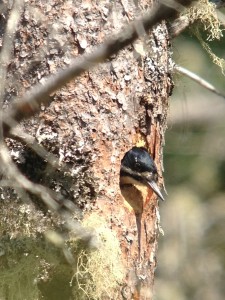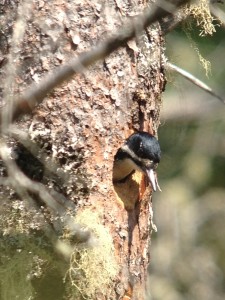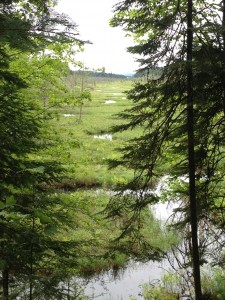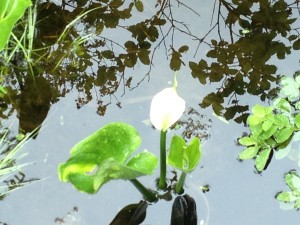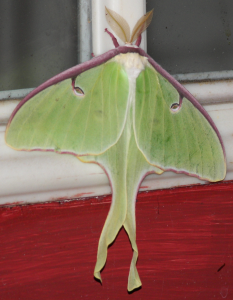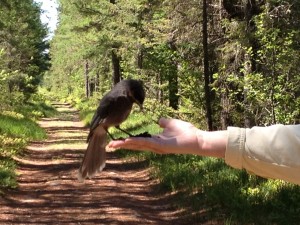Archive for June 2013
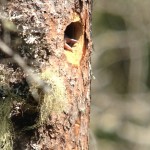
In early May, I found a couple different Black-backed Woodpecker nest sites. The male does all the excavation of the nest hole, which can be in a live tree, dead snag, or even a telephone pole! I have observed nests that ranged from 15 feet above the ground to 65 feet above the ground. One particular nest location this year was in a dead snag about 15 feet above ground. I frequently observed this nest site with clients over the past couple months. It was discovered by many local birders and people frequented the location daily, including folks out walking their dogs.
The male not only does all of the excavation, but he does all of the nighttime incubation and almost all of the fecal sac removal to keep the nest hole clean once the young are born. It was lovely to see how hard both parents worked to constantly feed the very loud nestlings! Black-backed Woodpecker young vocalize non-stop with a constant churring noise coming from the nest hole. You wonder how they survive when they make so much noise. The vocalizations became louder as adults flew in with food – so we would spend time talking and as the young became louder, it would alert us to another feeding session. When the young are big enough, the parents feed them by leaning in the hole. I ended up with lots of photographs of the baby heads sticking out seeking food. I observed two heads, and one client saw three heads at the hole. (They typically have 3 to 4 young.)
I observed a couple of interesting behaviors to note. The parents would sometimes give a softer version of their “kyik” call note and the young would immediately fall silent in the nest hole. It was apparent that it was a signal to be quiet. Also, several times the female Black-backed Woodpecker entered the hole and stuck her head out – sometimes with the bill sticking straight out and sometimes with her head and bill pointed down. This behavior would usually last about 15 to 20 minutes and the young would be completely silent during this period. It appeared to me that she feared a predator and was in a defensive position. Larry Master also noted this behavior when he visited the nest site, and said that he, too, noticed it was the female that was in a defensive position. Larry said that a couple of Common Grackles tried to predate the nest and that the Black-backed Woodpecker adults chased them off. Sean O’Brien once observed a Black-backed Woodpecker in this defensive position inside a nest hole that nailed the face of a Red Squirrel attempting to predate a nest in the same area.
On June 23, 2013, I was with a couple clients and we hiked to the Black-backed Woodpecker nest site. I was a bit concerned as we approached the nest and I did not hear the churring of the young. I set up my scope to view the nest hole, which is out in a swamp area, and I looked into the scope and viewed a Red Squirrel face looking out of the nest hole. I felt sick at the sight. After nearly two months of non-stop work by both parents, they were frantic. The male drummed non-stop on a dead snag next to the nest hole tree, and the female kept flying in to try and peck the squirrel, but she kept flying up as the squirrel would lunge at her. They called – both their short calls and the rattle call. It was an awful scene. We tried different things to get the squirrel to come out of the hole, but it was futile. My clients said they couldn’t stand to watch it any longer so we left. There were no sounds of the young. The young would have fledged in just a few days and they would have continued to be fed by the adults outside the nest. Young in a nest are so helpless, and it was so disturbing to see such a tragic end for these woodpecker babies. Some of the photographs I took over two months are below.
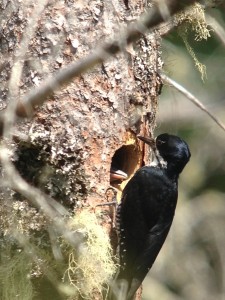
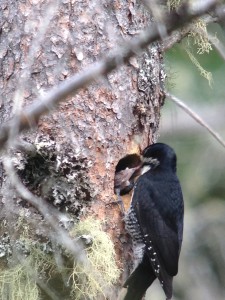
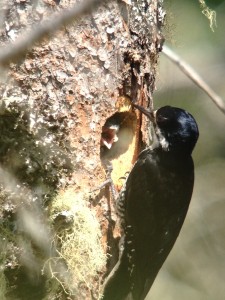
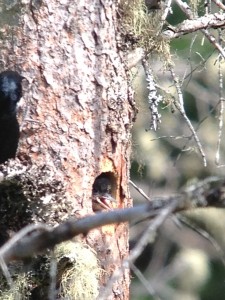
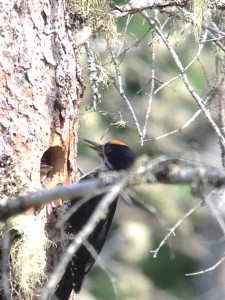
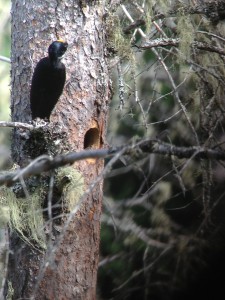
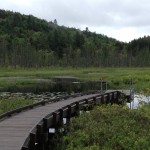
The 9th annual Adirondack Birding Festival was held this past weekend from June 7th to June 9th. Many birders return year after year for this event, and it is always wonderful to see familiar faces on the field trips! The Hamilton County Department of Economic Development & Tourism organizes the event each year. Field trips are spread across large Hamilton County and areas surrounding the county. There is no registration fee to attend, and the county assists birders with where to stay depending on their registered field trip locations. Next year will mark the 10th year of the Adirondack Birding Festival and there will be even more field trips added as this event continues to grow each year.
Dr. Bruce Beehler, of Conservation International, returned again this year and helped lead field trips in addition to speaking on Saturday evening. The presentation featured a fascinating mix of Dr. Beehler’s extensive knowledge of conservation issues and spectacular bird photos from around the world.
I led trips at Ferd’s Bog, Brown’s Tract Inlet, Low’s Ridge/Upper Dam Trail, and Moose River Plains. It was raining at Ferd’s Bog, so things were fairly quiet on that hike! (A participant re-visited the bog on Sunday afternoon and confirmed that Olive-sided Flycatchers are nesting there again this year!) The rain let up as we transitioned to Brown’s Tract Inlet (photos included). Just before the long, lovely board-walk (a canoe put-in, but terrific for birders!), we had great views of a Canada Warbler and Northern Waterthrush. Low’s Ridge/Upper Dam Trail was a hit with participants. We found 16 warbler species and had nice scope views of a singing Lincoln’s Sparrow in the bog section of the hike. The highlight was watching the “changing of the guard” at a Common Loon nest as the adults changed places in their typically awkward way! A large Snapping Turtle was observed laying eggs near the Upper Dam on the Bog River. At Moose River Plains we had lovely scope views of a singing Blackburnian Warbler perched at the top of a spruce tree. Boreal Chickadees were heard (one participant had a view), but remained mostly hidden as they are actively nesting. It was particularly exciting this year to have a new birder on this field trip who showed tremendous enthusiasm for every bird she viewed! Sixty-four species were tallied on these particular field trips.
There is a great deal of talk regarding the lack of neotropical migrants in our area this year. Breeding Bird Survey (BBS) data will probably shed more light on birders’ observations. Lincoln’s Sparrow, a bird that is usually abundant in bogs, is virtually missing! We found only one Lincoln’s Sparrow along the mile-long, huge bog on the Low’s Ridge/Upper Dam Trail – where you would normally find many. (It is the same situation in other bogs I frequent.) We found none at Ferd’s Bog and Brown’s Tract Inlet. Indigo Buntings are hard to find this year, as are Veeries, and Rose-breasted Grosbeaks. The numbers of birds appear to be way down, with an eerily quiet dawn chorus. One of the potential reasons was extreme weather events occurring as migrants were making their way around or over the Gulf of Mexico. Additional time and data will hopefully shed light on this worrisome situation.
Once again this year, several field trip leaders spent the weekend at our home. Between early field trips, meals, and nighttime discussions of classical music, literature, and of course birds(!), it was a sleepless weekend! My 18 year-old informed me that I hang out with very interesting people! I would agree that birders are fascinating folks!
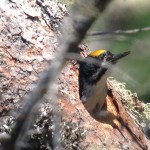
When I lead dawn tours up Whiteface Mountain, I rise at 1 a.m. and leave the house at 2:30 a.m. Some clients stay in Long Lake and we do some nocturnal birding together along the way, and some choose to stay closer to Whiteface so they can sleep longer! I am often asked how I can get up so early. There are wonderful benefits to being up during the night. For instance, on June 5th, I got up at 1 a.m. and heard noises outside. It was an Ermine (or Short-tailed Weasel) running around our front lawn! I also found a Luna Moth perched on our home (photograph included) and heard a fox vocalizing in the forest. During my drives to Whiteface, I find many nocturnal creatures such as Red and Gray Foxes, Eastern Coyotes, Porcupines, Raccoons, Deer, Fishers, and Minks. At stops with clients we often hear owls: Barred Owls, Northern Saw-whet Owls, and Great Horned Owls, and other species such as Beavers, Ruffed Grouse, Wilson’s Snipe, American Woodcock, Common Loons, and American Bitterns. On June 5th, as I approached Whiteface Mountain in the pre-dawn glow, there was a sliver moon over the majestic mountain and it was breathtaking. I spent the day with a couple from Long Island, NY and the day had perfect weather conditions. It was very cold on the summit of Whiteface Mountain at dawn, so we had no insects to bother us! We found 62 species (including 17 warbler species) by visiting Whiteface Mountain, Bloomingdale, and Lake Placid – species listed below:
Mallard
Common Merganser
Rock Pigeon
Mourning Dove
Belted Kingfisher
Yellow-bellied Sapsucker
Hairy Woodpecker
Black-backed Woodpecker – both the male and female at their nest location (photo included)
Northern Flicker
Yellow-bellied Flycatcher
Alder Flycatcher
Least Flycatcher
Eastern Phoebe
Blue-headed Vireo
Red-eyed Vireo
Gray Jay – 2 juveniles and 1 adult eating raisins from hands! (photo included)
Blue Jay
American Crow
Common Raven
Tree Swallow
Cliff Swallow – adorable nest sites!
Barn Swallow
Black-capped Chickadee
Boreal Chickadee – lovely scope views on Whiteface Mountain during our descent at about 3500’
Red-breasted Nuthatch
Brown Creeper
House Wren
Winter Wren
Golden-crowned Kinglet
Ruby-crowned Kinglet
Eastern Bluebird
Veery
Bicknell’s Thrush (15 to 20) with a few, brief visuals
Swainson’s Thrush (~10)
Hermit Thrush
American Robin
European Starling
Cedar Waxwing
Nashville Warbler
Northern Parula
Chestnut-sided Warbler
Magnolia Warbler
Cape May Warbler – lovely views of one!
Black-throated Blue Warbler
Yellow-rumped Warbler
Black-throated Green Warbler
Blackburnian Warbler
Pine Warbler
Palm Warbler
Black-and-white Warbler
Blackpoll Warbler
American Redstart
Ovenbird
Mourning Warbler
Common Yellowthroat
Scarlet Tanager
Chipping Sparrow
Song Sparrow
Swamp Sparrow
White-throated Sparrow
Dark-eyed Junco
Common Grackle
Purple Finch
American Goldfinch
I greatly enjoy the dawn tours up Whiteface Mountain because I am fascinated by high elevation bird species and it is always lovely to be awake during the Adirondack nights!
